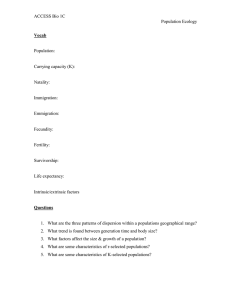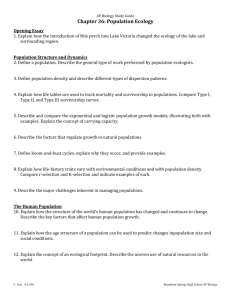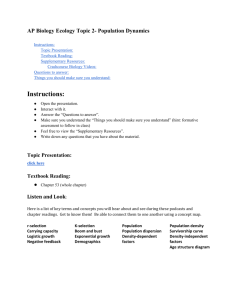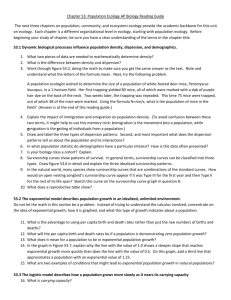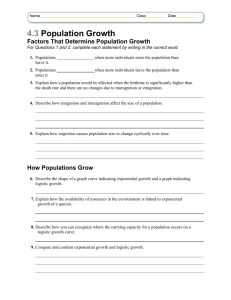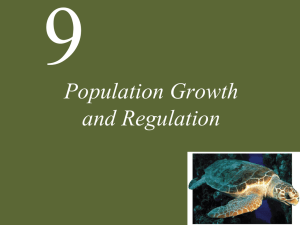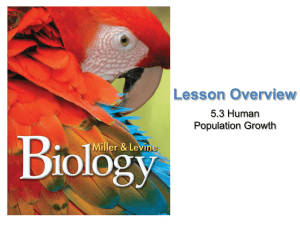Ecology of Populations
advertisement
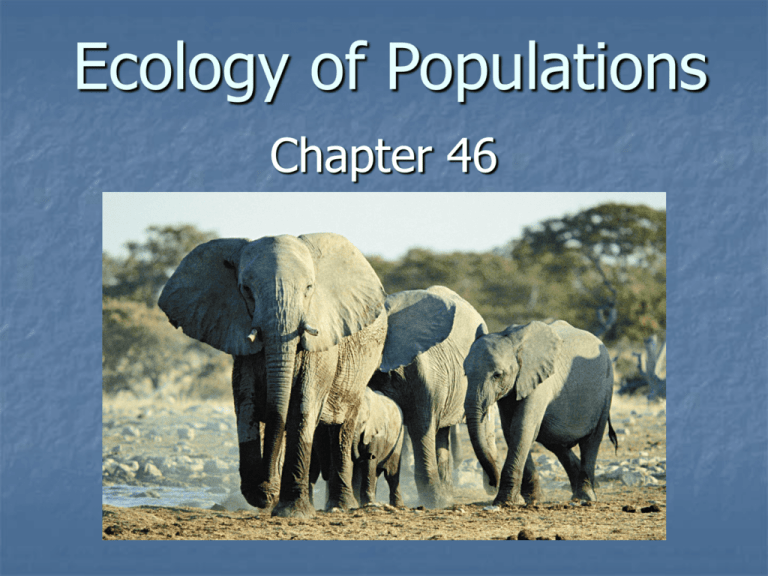
Ecology of Populations Chapter 46 Chapter Outline Scope of Ecology Population Density and Distribution Population Growth Models Survivorship Curves Age Distributions Regulation of Population Size Life History Patterns Human Population Growth Environmental Impact Scope of Ecology Ecology – what is it? Definitions: Habitat - Place where an organism lives. Population - All the organisms within an area belonging to the same species. Community - All various populations interacting at same locale. Ecosystem – A collection of communities Ecological Levels Density and Distribution of Populations Population Density - Number of individuals per unit area or volume. Population Distribution - Pattern of dispersal of individuals within the area of interest. Uniform Distribution Random Distribution Clumped Distribution Characteristics of Populations They tend to grow Intrinsic Rate of Natural Increase (r) Population Growth Models Exponential Growth Biotic Potential Environmental Resistance Exponential Growth Curve Logistic Growth Logistic growth—indicated by an S-shaped curve Difference between logistic and exponential due to environmental resistance Logistic Growth Carrying Capacity Carrying Capacity is the maximum number of individuals of a given species the environment can support. The closer the population to the carrying capacity, the greater the environmental resistance. Biotic potential is having full effect and birthrate is a maximum during exponential growth. St. Paul Island Reindeer Population Mortality Patterns Cohort --- all the members of a population born at the same time. Survivorship---the probability of newborn individuals of a cohort surviving to particular ages. Illustrated by Survivorship Curves Survivorship Curves Survivorship Curves Age Distributions What proportion of population is in each cohort? Age Structure Diagrams U.S. Age Distributions Regulation of Population Size Density - Dependent Factors Density - Independent Factors Factors That Affect Population Size Density Dependent Factors 1. 2. Competition Intraspecific Interspecific Predation 3. Parasitism 4. Disease Factors That Affect Population Size Density Independent Factors 1. Abiotic factors 2. Unpredictable, catastrophic events Life History Patterns r - Strategists (Opportunistic) Remember r=reproduction Life History Patterns k - Strategists (Equilibrium) Remember kapacity k=Karrying Human Population Growth Human population has had an exponential growth pattern. Doubling time currently estimated at 53 years. Population Size 1800 1930 1960 2000 1 2 3 6 Billion Billion Billion Billion World Population Growth Country Development More-Developed Countries (MDCs) GR=0.1% Less-Developed Countries (LDCs) GR= 1.6% LDC population expected to increase from 5-8b by 2050 Age Distributions Age Structure Diagrams divide populations into three age groups. Pre-Reproductive Reproductive Post-Reproductive The Demographic Transition Stage I: high birthrates and death rates Stage II: continued high birthrates, declining death rates Stage III: falling birthrates and death rates, eventually stabilizing More-Developed Countries Less-Developed Countries Age Distribution of the World’s Population Population Structures by Age and Sex, 2005 Millions Less Developed Regions More Developed Regions Age Male 300 200 100 Female 0 100 200 300 80+ 75-79 70-74 65-69 60-64 55-59 50-54 45-49 40-44 35-39 30-34 25-29 20-24 17-19 10-16 5-9 0-4 Male 300 Female 100 100 300 Source: United Nations, World Population Prospects: The 2002 Revision (medium scenario), 2003. Figure 7.2 World Population Distribution by Region, 1998 and 2050 Environmental Impact Measured in terms of: Population Size Resource Consumption Per Capita Resultant Pollution Environmental Impact Review Scope of Ecology Population Density and Distribution Population Growth Models Survivorship Curves Age Distributions Regulation of Population Size Life History Patterns Human Population Growth Environmental Impact
